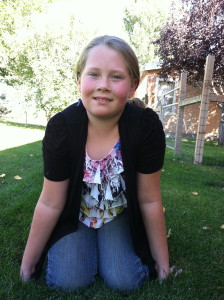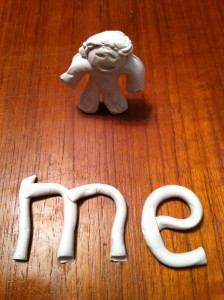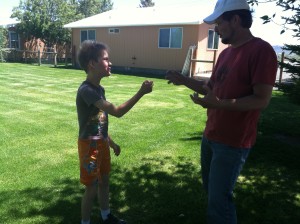For simplicity, we have chosen to use “Autism” as the umbrella term for Autism, Asperger Syndrome (AS), High Functioning Autism (HFA) or pervasive Developmental Disorder-Not Otherwise Specified (PDD-NOS). Our Autism approach is a non-invasive, client guided, gentle approach designed to allow autistic individuals to participate more fully in life. This one-on-one program can be conducted by an ON Point Autism Facilitator or by a parent or loved one who can be trained and mentored by an On Point Autism Facilitator- Coach.
Changes in our autistic clients are monitored by use of well- established questionnaires completed by parents/caregivers before and after the program. All personal data is treated confidentially. Early results indicate the area most likely to change is social skills.
Davis Autism Approach® is a three step program:
Firstly: Orientation- Bringing the senses into alignment.
When we enter the world as a baby one of the first jobs we have to do as a human being is to bring our senses into alignment. All of our neural networks nee d to be in harmony in order to be able to perceive our world accurately and consistently. This process is driven by our natural urges and is the first step towards controlling our emotions and behaviors. The name given to this process is Orientation. Typically a child achieves this in the first two years or so of their life. An individual who is on the autism spectrum does not complete this process and therefore remain in a disoriented state resulting in an inability to filter what is perceived which leads to confusion, chaos, a state of being overwhelmed and may lead to struggles with motor or sensory functions as well as delayed communication skills, self regulation, and emotional responses.
d to be in harmony in order to be able to perceive our world accurately and consistently. This process is driven by our natural urges and is the first step towards controlling our emotions and behaviors. The name given to this process is Orientation. Typically a child achieves this in the first two years or so of their life. An individual who is on the autism spectrum does not complete this process and therefore remain in a disoriented state resulting in an inability to filter what is perceived which leads to confusion, chaos, a state of being overwhelmed and may lead to struggles with motor or sensory functions as well as delayed communication skills, self regulation, and emotional responses.
The first step is to assist the individual to orient giving the ability to control their perceptions, mental focus, mood, and energy level. We use a variety of methods to achieve this such as kinesthetic, visual, or auditory depending on the individual’s strengths. Orientation leads to individuation which also takes place during early childhood development when a child becomes aware that he or she is a separate individual with opinions and feelings that are different from those held by others, and thus, rejects suggestions or requests made by others. We refer to this as the “terrible twos”, even though we know it is a healthy and desired developmental step! Children with autism either fail to complete this step in development, or regress after beginning down the path. To ensure this step has been completed we then assist the individual to create a model which can represent them in the next part of the process.
Secondly: Identity Development- Exploring ‘life’s natural lessons’.

Identity development refers to the learning that normally takes place as children grow and learn concepts that help them to understand how the world works and how they work. When individuals are disoriented much of the time, they do not learn or fully comprehend many of these basic concepts, these ‘life lessons’, and so they do not have a good or complete understanding of how things work, and ho they fit into the world. For example, the;y may not understand about change or consequence, and so continue to repeat the same behaviors, expecting a different outcome. They may not understand “authority”, and so refuse to accept any authority except their own desires, much as a very young child normally does.
Identity development provides a sense of self, and one’s place in the real world of cause and effect. There are approximately 30 concepts, which are addressed throughout this stage, starting with ‘change’ and ending with ‘responsibility’. These life concepts are explored at a pace that is comfortable for the individual both conceptually and environmentally. We say “one concept per day” as a general guide. However, this can be sped up or spread out over many months, as required.
Each concept is introduced by creating a model in plastalina clay. The concept is then explored in the environment, looking for and gaining understanding through experiencing real world examples. When a concept has been fully integrated we can move on to the next, as we have created a solid foundation for the new knowledge. We have experienced great success with individuals who are diagnosed as high functioning autistics. However, with patience and empathy, a way forward can be found for those with limited language and motor skills once the orientation methods have been integrated.
Thirdly: Social Integration- Relationship Concepts.
Social integration is the final area to be addressed. Once a person has a sense of his/her plac e in the world, he/she is ready to begin the task of understanding how relationships work and learning how he can fit into the world of people. This is the final stage in the On Point Autism Program. Again these concepts are explored through creating clay models, followed by matching them to life experience.
e in the world, he/she is ready to begin the task of understanding how relationships work and learning how he can fit into the world of people. This is the final stage in the On Point Autism Program. Again these concepts are explored through creating clay models, followed by matching them to life experience.
Professional services described as Davis®, including Davis Dyslexia Correction®, Davis Symbol Mastery®, Davis Orientation Counseling®, Davis® Attention Mastery, Davis® Math Mastery, and Davis® Reading Program for Young Learners may only be provided by persons who are trained and licensed as Davis Facilitators or Specialists by Davis Dyslexia Association International.

Davis® , Davis Autism Approach®, Davis® Stepping Stones, and Davis® Concepts for Life are trademarks of Ronald D. Davis. Commercial use of these trademarks to identify educational, instructional, or therapeutic services requires licensing by the trademark owner.

